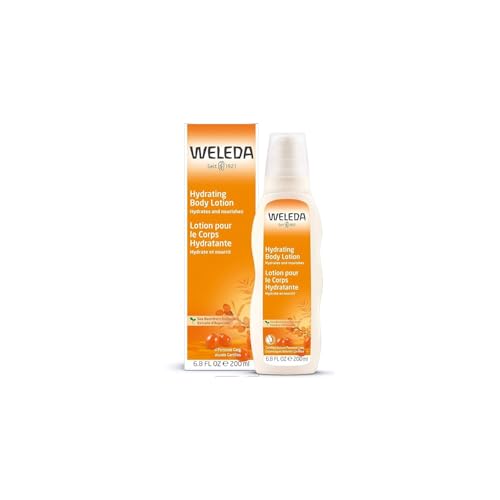
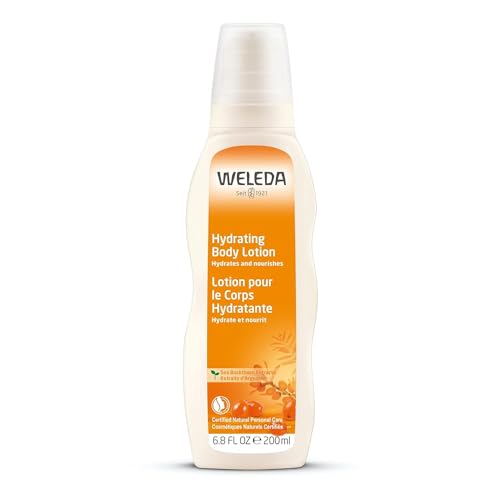
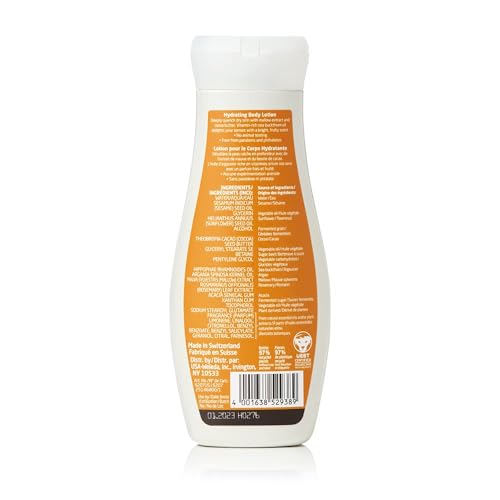
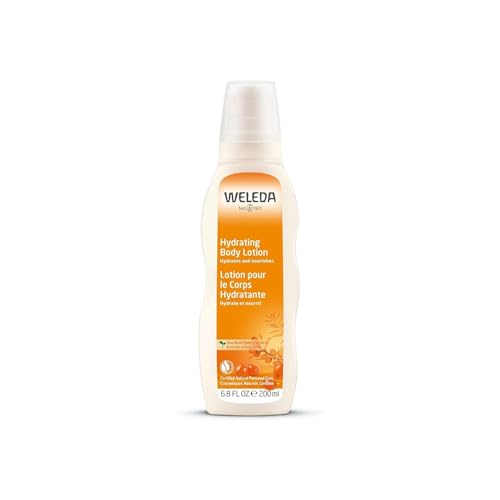
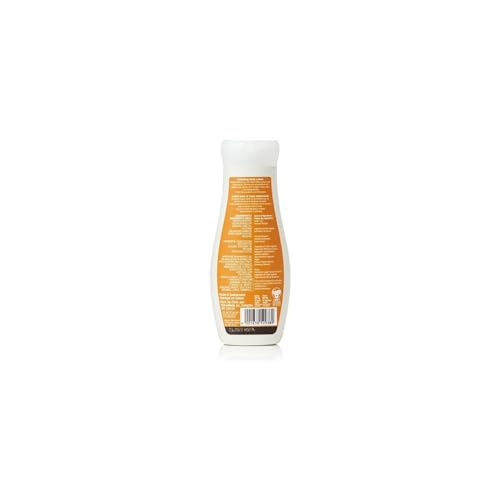
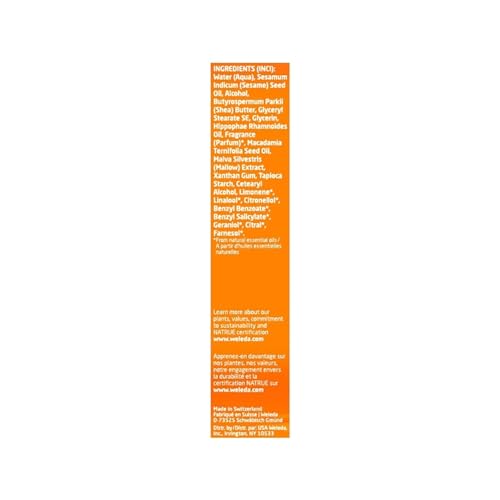
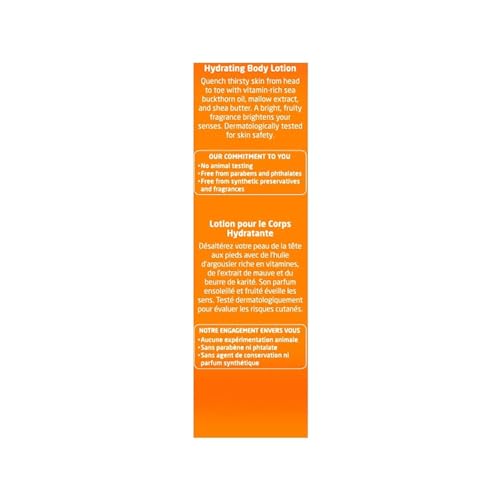
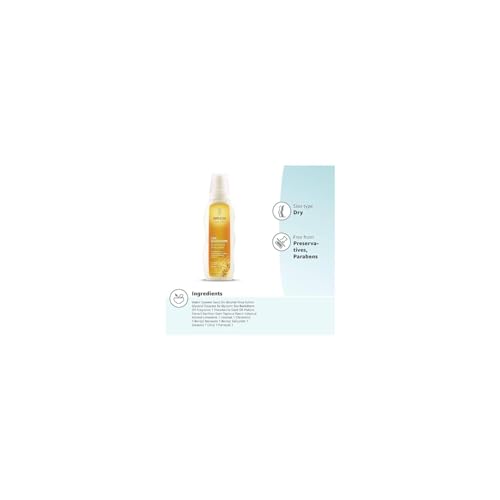
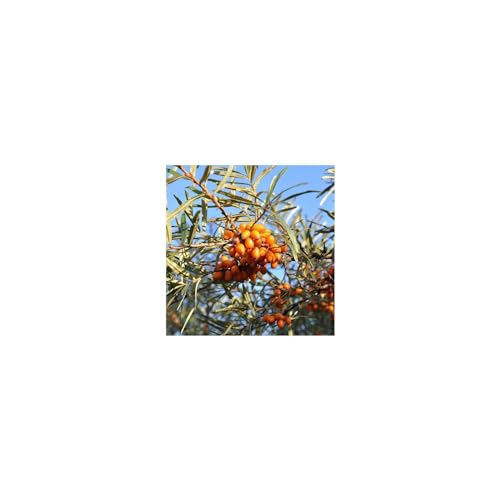
Weleda Body Lotion - Deep Hydration, Natural Sea Buckthorn Extract - 6.8 fl oz


Benzyl Salicylate
High RiskBenzyl salicylate is an ester of benzyl alcohol and salicylic acid, commonly used in personal care products as a fragrance component and UV filter. It is known for its ability to enhance product stability and provide a pleasant scent.
Sustai Insights
Benzyl salicylate offers functional benefits such as UV protection and fragrance enhancement. However, it is associated with a high allergenic potential and is categorized as a skin irritant, posing significant health risks. Environmental risks include its potential to act as a pollutant. Regulatory authorities have imposed restrictions on its use due to these concerns. Overall, it is assessed as high risk, necessitating caution in usage and consideration of safer alternatives.
Geraniol
High RiskGeraniol is a naturally occurring scent ingredient commonly found in essential oils from plants such as geraniums and lemongrass. It is primarily used for its pleasant floral aroma in perfumes, cosmetics, and household products.
Sustai Insights
Geraniol serves as a fragrance component and offers a natural option for scenting products. However, it has a high allergenic potential and may cause skin irritation in sensitive individuals. While it is considered low risk for carcinogenicity and reproductive toxicity, regulatory bodies have placed restrictions on its use due to allergenic concerns. Overall, the assessment reflects a high-risk level, particularly for those prone to allergies, highlighting the need for caution in its application.
Citral
High RiskCitral is a naturally occurring scent ingredient primarily used for its lemon-like fragrance in various products, including perfumes, cosmetics, and food. It is derived from essential oils such as lemon myrtle and lemongrass.
Sustai Insights
Citral offers functional benefits as a fragrance component, enhancing product appeal. However, it is associated with a high risk of allergy and irritation, particularly affecting the skin, eyes, and respiratory system. While its carcinogenicity and reproductive toxicity concerns are low, citral's environmental impact as a potential irritant raises caution. Regulatory bodies note usage restrictions due to its allergenic potential, leading to an overall high-risk assessment. Safe practices include patch testing for allergies, and alternatives such as synthetic fragrances may offer lower irritation risks.
Farnesol
High RiskFarnesol is a flavor and perfume ingredient found in various cosmetic and personal care products. It is primarily used for its scent and potential antimicrobial properties, contributing to the overall fragrance profile of formulations.
Sustai Insights
Farnesol offers functional benefits as a fragrance component, but it raises significant health concerns, particularly its high allergenic potential. Regulatory bodies have imposed restrictions on its usage due to these risks. Environmentally, it poses risks as a potential pollutant, though it is not classified as bioaccumulative. Overall, the risk level associated with farnesol is high, necessitating careful consideration in product formulation and use. Alternatives such as natural essential oils may provide safer options.
Citronellol
High RiskCitronellol is a naturally occurring scent ingredient commonly found in various essential oils. It is primarily used for its aromatic properties in perfumes, cosmetics, and household products, contributing to fragrance profiles.
Sustai Insights
Citronellol serves as a fragrance component, enhancing product appeal. However, it has a high allergenic potential, posing risks of skin irritation and sensitization. Environmental concerns include contamination risks. Regulatory bodies have restrictions on its use, emphasizing caution. Overall, citronellol presents a high risk regarding health and safety, warranting careful consideration in product formulations.
Benzyl Benzoate
High RiskBenzyl benzoate is a compound commonly utilized as a solvent and preservative in various products. It is also used in formulations for its fragrance and as a potential anti-parasitic treatment in certain topical applications.
Sustai Insights
Benzyl benzoate serves effectively as a preservative and solvent, contributing to product stability. However, it presents a high risk of allergy and immunotoxicity while exhibiting low concerns for carcinogenicity and reproductive toxicity. Environmentally, it poses minimal ecotoxicological risks and is not bioaccumulative. Regulatory bodies have noted its restricted use in verified products, emphasizing caution. Overall, the ingredient is assessed as high risk, and safer alternatives should be considered for sensitive applications.
Linalool
High RiskLinalool is a terpene commonly found in various plants, particularly in lavender and mint. It is primarily used in products for its fragrance and potential antimicrobial properties. Linalool is also utilized in formulations for its ability to enhance the sensory experience of personal care and household products.
Sustai Insights
Linalool offers functional benefits as a naturally occurring fragrance component and may exhibit antimicrobial properties. However, it presents high allergenic potential, with concerns about skin irritation and sensitization. Environmental risks include contamination issues, though it is not classified as a persistent pollutant. Regulatory bodies have noted the need for careful handling due to its allergenic nature. Overall, despite some beneficial attributes, the ingredient carries a high risk profile, warranting cautious use and consideration of safer alternatives.
Fragrance
High RiskFragrance refers to a mixture of aromatic compounds used in products to provide scent. It is commonly listed as 'fragrance' or 'parfum' on product labels and can serve various functions, including enhancing user experience and masking undesirable odors.
Sustai Insights
Fragrance offers functional benefits by improving product appeal; however, it poses significant health risks, notably a high likelihood of causing allergies and allergic contact dermatitis. Environmental risks include potential pollution and endocrine disruption, though its overall carcinogenicity is low. Regulatory bodies have noted concerns regarding its use, leading to a high-risk classification. Safe usage practices should be observed, and alternatives such as natural essential oils are recommended for those sensitive to synthetic fragrances.
Rosmarinus Officinalis (Rosemary) Leaf Extract
Medium RiskRosemary leaf extract is produced from the leaves of the Rosmarinus officinalis plant. It is commonly used in cosmetic formulations for its potential antioxidant properties and fragrance. The extract may also contribute to the preservation of products due to its antimicrobial characteristics.
Sustai Insights
Rosemary leaf extract offers functional benefits such as antioxidant and antimicrobial properties, which can enhance product stability and shelf-life. It is generally considered low risk for carcinogenicity and reproductive toxicity, but it carries a moderate potential for allergic reactions. Environmentally, it poses low risk with no significant pollutant or bioaccumulation concerns. Regulatory bodies have not placed significant restrictions on its use, although some verified products cannot contain certain concentrations. Overall, the ingredient's risk level is medium, necessitating careful usage practices to mitigate allergic responses.
Acacia Senegal Gum
Medium RiskAcacia senegal gum is derived from the dried sap of the Acacia senegal tree, primarily used as a thickening agent, emulsifier, and stabilizer in food and cosmetic products. It is recognized for its gelling properties and is often utilized in formulations to improve texture and consistency.
Sustai Insights
Acacia senegal gum offers functional benefits such as emulsification and stabilization in products, and it is biodegradable, which contributes positively to sustainability. Health risks are generally low, with moderate concerns related to allergies. Environmental risks are minimal, although the ingredient is subject to regulatory oversight, including usage restrictions. Overall, the risk level is assessed as medium, and the ingredient should be used according to safety recommendations. Alternatives include other natural gums like guar gum or xanthan gum for similar stabilizing effects.
Betaine
Medium RiskBetaine is a zwitterion (inner salt) commonly used in personal care and cosmetic products. It functions primarily as a humectant, aiding in moisture retention, and can also act as a surfactant, contributing to the cleansing properties of formulations.
Sustai Insights
Betaine is recognized for its effective moisturizing and surfactant properties, making it beneficial in enhancing product performance. It is generally considered low risk for health concerns such as carcinogenicity, allergies, and reproductive toxicity. However, there are multiple additive exposure sources to consider. Environmentally, it poses low risks regarding pollution and bioaccumulation. Regulatory status indicates it is approved for use with no significant restrictions. Overall, it presents a medium risk level, and safe usage practices should be observed. Alternatives include glycerin or sorbitol for similar benefits.
Glycerin
Medium RiskGlycerin (also called glycerol) is a naturally occurring compound commonly used in personal care and cosmetic products. It functions as a humectant, attracting moisture to the skin, and is also utilized as a solvent and emollient to enhance product texture and stability.
Sustai Insights
Glycerin is valued for its effective moisturizing properties and biodegradability, making it a widely accepted ingredient in formulations. It poses low health risks, including low concerns for carcinogenicity and allergies. However, moderate use restrictions exist due to regulatory guidelines. While glycerin does not significantly contribute to environmental pollution, its production process should be ethically sourced. Overall, glycerin holds a medium risk level, emphasizing the importance of safe usage practices and considering sustainable alternatives.
Limonene
Medium RiskLimonene is a scent ingredient and solvent naturally found in citrus fruits, commonly used in personal care and cleaning products for its fragrant properties. It serves as a flavoring agent and enhances the overall sensory experience of products.
Sustai Insights
Limonene offers functional benefits such as acting as a solvent and fragrance enhancer. However, it carries a high allergenic potential, which can trigger skin or respiratory sensitivities in some individuals. Environmental concerns include moderate persistence and bioaccumulation, along with potential ecotoxicity. Regulatory restrictions necessitate verification in products containing this ingredient. Overall, the risk level is assessed as medium, emphasizing the importance of cautious use, particularly for sensitive populations. Safer alternatives may be considered to mitigate these risks.
Pentylene Glycol
Low RiskPentylene glycol is a synthetic, low molecular weight glycol that functions primarily as a humectant, solvent, and skin-conditioning agent in cosmetic formulations. It is commonly used to enhance product texture and moisture retention.
Sustai Insights
Pentylene glycol offers functional benefits as a humectant, effectively attracting moisture to the skin. It is generally considered to have low health risks, with minimal concerns regarding carcinogenicity, allergies, or developmental toxicity. However, it may cause mild skin, eye, or lung irritation in sensitive individuals. Environmentally, it poses low risk as it is not bioaccumulative or a significant pollutant. Regulatory bodies have not imposed restrictions on its use. Overall, it presents a low risk profile, making it a safe choice in cosmetic formulations, with no significant adverse effects reported.
Glyceryl Stearate Se
Low RiskGlyceryl stearate SE is a self-emulsifying ingredient commonly used in cosmetic formulations to stabilize and thicken products. It acts as an emulsifier, helping to blend oil and water components effectively, which enhances the product's texture and stability.
Sustai Insights
Glyceryl stearate SE offers functional benefits as an emulsifier, promoting stability in formulations. It is considered low risk for health concerns, including cancer, allergies, and reproductive toxicity, with no significant environmental hazards reported. Regulatory bodies have not imposed restrictions on its use. Safe usage practices suggest following recommended concentrations in products. Overall, this ingredient is assessed as low risk, with no immediate alternatives needed.
Hippophae Rhamnoides (Sea Buckthorn) Oil
Low RiskHippophae rhamnoides oil, commonly known as sea buckthorn oil, is a fixed oil extracted from the berries of the sea buckthorn plant. It is primarily used in cosmetic formulations for its moisturizing and skin-nourishing properties, often incorporated for its fatty acid profile and antioxidant content.
Sustai Insights
Hippophae rhamnoides oil offers functional benefits such as skin hydration and potential antioxidant effects, contributing to improved skin health. It is sustainably sourced and biodegradable. The ingredient is associated with low health risks, including minimal concerns for carcinogenicity, allergies, and reproductive toxicity. Environmental risks are also low, with no significant pollutant or bioaccumulation potential identified. Regulatory status indicates no severe restrictions. Overall, this ingredient is assessed as low risk and safe for use in cosmetic products, with no specific safer alternatives readily available.
Sodium Stearoyl Glutamate
Low RiskSodium stearoyl glutamate is a surfactant and emulsifier commonly used in cosmetic formulations. It helps stabilize mixtures of oil and water, enhancing the texture and feel of products. This ingredient is derived from glutamic acid and stearic acid, and it is typically found in skin care and hair care products.
Sustai Insights
Sodium stearoyl glutamate offers functional benefits as an emulsifier, effectively improving product consistency. It is considered to have low health risks regarding carcinogenicity, allergies, and reproductive toxicity. Environmental impact is minimal, with no significant pollutant or bioaccumulation concerns noted. Regulatory bodies do not impose serious restrictions on its use. Overall, it is assessed as low risk, making it a suitable ingredient in cosmetic formulations. Safe usage practices should be followed, and alternatives are available for those seeking different emulsifying agents.
Argania Spinosa (Argan) Kernel Oil
Low RiskArgania spinosa (argan) kernel oil is a fixed oil extracted from the kernels of the argan tree, native to Morocco. It is commonly used in cosmetic formulations for its moisturizing properties, serving as an emollient and skin conditioner.
Sustai Insights
Argania spinosa kernel oil offers functional benefits such as effective hydration and nourishment for the skin and hair. It is sustainably sourced and biodegradable, contributing positively to environmental considerations. Health risks are low, with minimal concerns regarding carcinogenicity, allergies, or reproductive toxicity. There are no current regulatory restrictions on its use. Overall, it poses low risk, making it a suitable ingredient in cosmetic products. Safe usage practices should be maintained, and alternatives like jojoba oil may also be considered for similar benefits.
Ethanol
Low RiskEthanol, also known as ethyl alcohol, is a volatile, colorless liquid commonly used as a solvent, preservative, and antiseptic in various personal care products. It serves as a penetration enhancer, improving the absorption of other ingredients through the skin.
Sustai Insights
Ethanol functions effectively as a preservative and solvent, offering benefits such as enhanced ingredient absorption and antimicrobial properties. It is biodegradable and can be sustainably sourced. Health risks are minimal, with low concerns for carcinogenicity, allergies, and developmental toxicity. Environmental impacts are also low, with no significant pollutant potential. Regulatory agencies do not impose restrictions on its use. Overall, ethanol is considered low risk, making it a widely accepted ingredient in personal care formulations.
Sesamum Indicum (Sesame) Oil
Low RiskSesamum indicum (sesame) oil is derived from the seeds of the sesame plant. It is commonly used in cosmetic formulations due to its emollient properties and ability to nourish the skin. This oil is rich in fatty acids and antioxidants, contributing to its effectiveness in various skincare products.
Sustai Insights
Sesame oil offers several functional benefits, including moisturization and nourishment for the skin, along with potential antioxidant properties. It is generally regarded as safe, with low concerns regarding carcinogenicity, allergies, and reproductive toxicity. Environmental risks are minimal, and the oil is not known to be bioaccumulative. Regulatory bodies do not impose significant restrictions on its use. Overall, sesame oil poses a low risk, making it a viable ingredient in cosmetic formulations, although consumers should consider potential allergies and choose responsibly sourced products.
Theobroma Cacao (Cocoa) Seed Butter
Low RiskTheobroma cacao (cocoa) seed butter is extracted from the roasted seeds of the cocoa plant. It is commonly used in cosmetics and skincare products for its emollient properties, helping to moisturize and soften the skin. Cocoa butter is also known for its stability and resistance to rancidity.
Sustai Insights
Cocoa butter is recognized for its effective moisturizing properties and is sustainably sourced, contributing to its appeal in personal care products. It poses low health risks, with minimal concerns regarding carcinogenicity, allergies, or reproductive toxicity. Environmentally, it does not significantly contribute to pollution or bioaccumulation. Regulatory bodies impose few restrictions, affirming its safety. Overall, the risk associated with cocoa seed butter is low, making it a favorable ingredient in cosmetics. Alternatives include shea butter or plant oils for similar emollient benefits.
Malva Sylvestris (Common Mallow) Extract
Low RiskMalva sylvestris (mallow) extract is derived from the common mallow plant, known for its soothing properties. It is primarily used in cosmetics and personal care products for its hydrating and anti-inflammatory effects, often included in formulations aimed at sensitive skin.
Sustai Insights
Malva sylvestris extract offers functional benefits such as skin hydration and soothing effects, making it suitable for sensitive skin formulations. It is sustainably sourced and poses low health risks, with no significant concerns related to carcinogenicity, allergies, or reproductive toxicity. Environmental impacts are minimal, and it is not associated with pollution or bioaccumulation. Regulatory bodies do not currently impose restrictions on its use. Overall, it is assessed as a low-risk ingredient, suitable for various applications.
Water
Low RiskWater is a clear, colorless liquid essential for various biological processes. It serves as a solvent in formulations, facilitating the dissolution of other ingredients and enhancing product texture and application. Additionally, water plays a crucial role in hydration and is a key component in many cosmetic and personal care products.
Sustai Insights
Water is an effective solvent and hydrator, contributing to the texture and efficacy of formulations. It is biodegradable and generally regarded as safe, with low concerns regarding carcinogenicity, allergies, and reproductive toxicity. However, excessive water usage can lead to environmental concerns, particularly regarding resource depletion. Regulatory bodies do not impose restrictions on water use in cosmetics. Overall, the risks associated with water are low, making it a safe and essential ingredient.
Tocopherol
Low RiskTocopherols are a class of naturally occurring compounds, primarily known for their role as antioxidants. They are commonly used in cosmetic and skincare products to help stabilize formulations and protect ingredients from oxidative damage.
Sustai Insights
Tocopherols provide functional benefits such as antioxidant protection and skin conditioning. They are generally recognized as safe, with low concerns regarding carcinogenicity, allergies, and reproductive toxicity. However, enhanced skin absorption and potential endocrine disruption are noted. Regulatory bodies have not imposed significant restrictions on tocopherols, categorizing the overall risk as low. Safe usage practices should be observed, and while alternatives exist, tocopherols remain a viable option in formulations.
Xanthan Gum
Low RiskXanthan gum is a polysaccharide, a sugar-based compound produced by the fermentation of glucose or sucrose. It is commonly used as a thickening agent and stabilizer in various food and cosmetic products due to its ability to improve texture and prevent ingredient separation.
Sustai Insights
Xanthan gum serves effectively as a thickener and stabilizer, enhancing product texture and consistency. It is biodegradable and typically derived from renewable sources, supporting sustainability efforts. Health risks are minimal, with low concerns regarding carcinogenicity, allergies, and reproductive toxicity. Environmental impact is similarly low, posing no significant hazards. Regulatory agencies, including the FDA, regard it as safe for use, with no significant restrictions. Overall, xanthan gum is assessed as low risk, making it a suitable ingredient in formulations.
Helianthus Annuus (Sunflower) Seed Oil
Low RiskHelianthus annuus (sunflower) seed oil is derived from the seeds of the sunflower plant. It serves primarily as an emollient and moisturizer in cosmetic formulations, helping to maintain skin hydration and improve texture.
Sustai Insights
Sunflower seed oil is effective as an emollient, providing moisture and improving skin texture while being biodegradable and sustainably sourced. It poses low health risks, including negligible concerns for carcinogenicity, allergies, or reproductive toxicity. Environmentally, it does not significantly contribute to pollution or bioaccumulation. Regulatory bodies currently do not list any advisories for this ingredient. Overall, it is assessed as low risk, with safe usage practices recommended. Alternatives include oils like jojoba or almond oil for those seeking different properties.
Rosmarinus Officinalis (Rosemary) Leaf Extract
Medium RiskRosemary leaf extract is produced from the leaves of the Rosmarinus officinalis plant. It is commonly used in cosmetic formulations for its potential antioxidant properties and fragrance. The extract may also contribute to the preservation of products due to its antimicrobial characteristics.
Sustai Insights
Rosemary leaf extract offers functional benefits such as antioxidant and antimicrobial properties, which can enhance product stability and shelf-life. It is generally considered low risk for carcinogenicity and reproductive toxicity, but it carries a moderate potential for allergic reactions. Environmentally, it poses low risk with no significant pollutant or bioaccumulation concerns. Regulatory bodies have not placed significant restrictions on its use, although some verified products cannot contain certain concentrations. Overall, the ingredient's risk level is medium, necessitating careful usage practices to mitigate allergic responses.
Benzyl Salicylate
High RiskBenzyl salicylate is an ester of benzyl alcohol and salicylic acid, commonly used in personal care products as a fragrance component and UV filter. It is known for its ability to enhance product stability and provide a pleasant scent.
Sustai Insights
Benzyl salicylate offers functional benefits such as UV protection and fragrance enhancement. However, it is associated with a high allergenic potential and is categorized as a skin irritant, posing significant health risks. Environmental risks include its potential to act as a pollutant. Regulatory authorities have imposed restrictions on its use due to these concerns. Overall, it is assessed as high risk, necessitating caution in usage and consideration of safer alternatives.
Geraniol
High RiskGeraniol is a naturally occurring scent ingredient commonly found in essential oils from plants such as geraniums and lemongrass. It is primarily used for its pleasant floral aroma in perfumes, cosmetics, and household products.
Sustai Insights
Geraniol serves as a fragrance component and offers a natural option for scenting products. However, it has a high allergenic potential and may cause skin irritation in sensitive individuals. While it is considered low risk for carcinogenicity and reproductive toxicity, regulatory bodies have placed restrictions on its use due to allergenic concerns. Overall, the assessment reflects a high-risk level, particularly for those prone to allergies, highlighting the need for caution in its application.
Acacia Senegal Gum
Medium RiskAcacia senegal gum is derived from the dried sap of the Acacia senegal tree, primarily used as a thickening agent, emulsifier, and stabilizer in food and cosmetic products. It is recognized for its gelling properties and is often utilized in formulations to improve texture and consistency.
Sustai Insights
Acacia senegal gum offers functional benefits such as emulsification and stabilization in products, and it is biodegradable, which contributes positively to sustainability. Health risks are generally low, with moderate concerns related to allergies. Environmental risks are minimal, although the ingredient is subject to regulatory oversight, including usage restrictions. Overall, the risk level is assessed as medium, and the ingredient should be used according to safety recommendations. Alternatives include other natural gums like guar gum or xanthan gum for similar stabilizing effects.
Pentylene Glycol
Low RiskPentylene glycol is a synthetic, low molecular weight glycol that functions primarily as a humectant, solvent, and skin-conditioning agent in cosmetic formulations. It is commonly used to enhance product texture and moisture retention.
Sustai Insights
Pentylene glycol offers functional benefits as a humectant, effectively attracting moisture to the skin. It is generally considered to have low health risks, with minimal concerns regarding carcinogenicity, allergies, or developmental toxicity. However, it may cause mild skin, eye, or lung irritation in sensitive individuals. Environmentally, it poses low risk as it is not bioaccumulative or a significant pollutant. Regulatory bodies have not imposed restrictions on its use. Overall, it presents a low risk profile, making it a safe choice in cosmetic formulations, with no significant adverse effects reported.
Betaine
Medium RiskBetaine is a zwitterion (inner salt) commonly used in personal care and cosmetic products. It functions primarily as a humectant, aiding in moisture retention, and can also act as a surfactant, contributing to the cleansing properties of formulations.
Sustai Insights
Betaine is recognized for its effective moisturizing and surfactant properties, making it beneficial in enhancing product performance. It is generally considered low risk for health concerns such as carcinogenicity, allergies, and reproductive toxicity. However, there are multiple additive exposure sources to consider. Environmentally, it poses low risks regarding pollution and bioaccumulation. Regulatory status indicates it is approved for use with no significant restrictions. Overall, it presents a medium risk level, and safe usage practices should be observed. Alternatives include glycerin or sorbitol for similar benefits.
Citral
High RiskCitral is a naturally occurring scent ingredient primarily used for its lemon-like fragrance in various products, including perfumes, cosmetics, and food. It is derived from essential oils such as lemon myrtle and lemongrass.
Sustai Insights
Citral offers functional benefits as a fragrance component, enhancing product appeal. However, it is associated with a high risk of allergy and irritation, particularly affecting the skin, eyes, and respiratory system. While its carcinogenicity and reproductive toxicity concerns are low, citral's environmental impact as a potential irritant raises caution. Regulatory bodies note usage restrictions due to its allergenic potential, leading to an overall high-risk assessment. Safe practices include patch testing for allergies, and alternatives such as synthetic fragrances may offer lower irritation risks.
Glyceryl Stearate Se
Low RiskGlyceryl stearate SE is a self-emulsifying ingredient commonly used in cosmetic formulations to stabilize and thicken products. It acts as an emulsifier, helping to blend oil and water components effectively, which enhances the product's texture and stability.
Sustai Insights
Glyceryl stearate SE offers functional benefits as an emulsifier, promoting stability in formulations. It is considered low risk for health concerns, including cancer, allergies, and reproductive toxicity, with no significant environmental hazards reported. Regulatory bodies have not imposed restrictions on its use. Safe usage practices suggest following recommended concentrations in products. Overall, this ingredient is assessed as low risk, with no immediate alternatives needed.
Farnesol
High RiskFarnesol is a flavor and perfume ingredient found in various cosmetic and personal care products. It is primarily used for its scent and potential antimicrobial properties, contributing to the overall fragrance profile of formulations.
Sustai Insights
Farnesol offers functional benefits as a fragrance component, but it raises significant health concerns, particularly its high allergenic potential. Regulatory bodies have imposed restrictions on its usage due to these risks. Environmentally, it poses risks as a potential pollutant, though it is not classified as bioaccumulative. Overall, the risk level associated with farnesol is high, necessitating careful consideration in product formulation and use. Alternatives such as natural essential oils may provide safer options.
Hippophae Rhamnoides (Sea Buckthorn) Oil
Low RiskHippophae rhamnoides oil, commonly known as sea buckthorn oil, is a fixed oil extracted from the berries of the sea buckthorn plant. It is primarily used in cosmetic formulations for its moisturizing and skin-nourishing properties, often incorporated for its fatty acid profile and antioxidant content.
Sustai Insights
Hippophae rhamnoides oil offers functional benefits such as skin hydration and potential antioxidant effects, contributing to improved skin health. It is sustainably sourced and biodegradable. The ingredient is associated with low health risks, including minimal concerns for carcinogenicity, allergies, and reproductive toxicity. Environmental risks are also low, with no significant pollutant or bioaccumulation potential identified. Regulatory status indicates no severe restrictions. Overall, this ingredient is assessed as low risk and safe for use in cosmetic products, with no specific safer alternatives readily available.
Citronellol
High RiskCitronellol is a naturally occurring scent ingredient commonly found in various essential oils. It is primarily used for its aromatic properties in perfumes, cosmetics, and household products, contributing to fragrance profiles.
Sustai Insights
Citronellol serves as a fragrance component, enhancing product appeal. However, it has a high allergenic potential, posing risks of skin irritation and sensitization. Environmental concerns include contamination risks. Regulatory bodies have restrictions on its use, emphasizing caution. Overall, citronellol presents a high risk regarding health and safety, warranting careful consideration in product formulations.
Benzyl Benzoate
High RiskBenzyl benzoate is a compound commonly utilized as a solvent and preservative in various products. It is also used in formulations for its fragrance and as a potential anti-parasitic treatment in certain topical applications.
Sustai Insights
Benzyl benzoate serves effectively as a preservative and solvent, contributing to product stability. However, it presents a high risk of allergy and immunotoxicity while exhibiting low concerns for carcinogenicity and reproductive toxicity. Environmentally, it poses minimal ecotoxicological risks and is not bioaccumulative. Regulatory bodies have noted its restricted use in verified products, emphasizing caution. Overall, the ingredient is assessed as high risk, and safer alternatives should be considered for sensitive applications.
Sodium Stearoyl Glutamate
Low RiskSodium stearoyl glutamate is a surfactant and emulsifier commonly used in cosmetic formulations. It helps stabilize mixtures of oil and water, enhancing the texture and feel of products. This ingredient is derived from glutamic acid and stearic acid, and it is typically found in skin care and hair care products.
Sustai Insights
Sodium stearoyl glutamate offers functional benefits as an emulsifier, effectively improving product consistency. It is considered to have low health risks regarding carcinogenicity, allergies, and reproductive toxicity. Environmental impact is minimal, with no significant pollutant or bioaccumulation concerns noted. Regulatory bodies do not impose serious restrictions on its use. Overall, it is assessed as low risk, making it a suitable ingredient in cosmetic formulations. Safe usage practices should be followed, and alternatives are available for those seeking different emulsifying agents.
Argania Spinosa (Argan) Kernel Oil
Low RiskArgania spinosa (argan) kernel oil is a fixed oil extracted from the kernels of the argan tree, native to Morocco. It is commonly used in cosmetic formulations for its moisturizing properties, serving as an emollient and skin conditioner.
Sustai Insights
Argania spinosa kernel oil offers functional benefits such as effective hydration and nourishment for the skin and hair. It is sustainably sourced and biodegradable, contributing positively to environmental considerations. Health risks are low, with minimal concerns regarding carcinogenicity, allergies, or reproductive toxicity. There are no current regulatory restrictions on its use. Overall, it poses low risk, making it a suitable ingredient in cosmetic products. Safe usage practices should be maintained, and alternatives like jojoba oil may also be considered for similar benefits.
Ethanol
Low RiskEthanol, also known as ethyl alcohol, is a volatile, colorless liquid commonly used as a solvent, preservative, and antiseptic in various personal care products. It serves as a penetration enhancer, improving the absorption of other ingredients through the skin.
Sustai Insights
Ethanol functions effectively as a preservative and solvent, offering benefits such as enhanced ingredient absorption and antimicrobial properties. It is biodegradable and can be sustainably sourced. Health risks are minimal, with low concerns for carcinogenicity, allergies, and developmental toxicity. Environmental impacts are also low, with no significant pollutant potential. Regulatory agencies do not impose restrictions on its use. Overall, ethanol is considered low risk, making it a widely accepted ingredient in personal care formulations.
Sesamum Indicum (Sesame) Oil
Low RiskSesamum indicum (sesame) oil is derived from the seeds of the sesame plant. It is commonly used in cosmetic formulations due to its emollient properties and ability to nourish the skin. This oil is rich in fatty acids and antioxidants, contributing to its effectiveness in various skincare products.
Sustai Insights
Sesame oil offers several functional benefits, including moisturization and nourishment for the skin, along with potential antioxidant properties. It is generally regarded as safe, with low concerns regarding carcinogenicity, allergies, and reproductive toxicity. Environmental risks are minimal, and the oil is not known to be bioaccumulative. Regulatory bodies do not impose significant restrictions on its use. Overall, sesame oil poses a low risk, making it a viable ingredient in cosmetic formulations, although consumers should consider potential allergies and choose responsibly sourced products.
Theobroma Cacao (Cocoa) Seed Butter
Low RiskTheobroma cacao (cocoa) seed butter is extracted from the roasted seeds of the cocoa plant. It is commonly used in cosmetics and skincare products for its emollient properties, helping to moisturize and soften the skin. Cocoa butter is also known for its stability and resistance to rancidity.
Sustai Insights
Cocoa butter is recognized for its effective moisturizing properties and is sustainably sourced, contributing to its appeal in personal care products. It poses low health risks, with minimal concerns regarding carcinogenicity, allergies, or reproductive toxicity. Environmentally, it does not significantly contribute to pollution or bioaccumulation. Regulatory bodies impose few restrictions, affirming its safety. Overall, the risk associated with cocoa seed butter is low, making it a favorable ingredient in cosmetics. Alternatives include shea butter or plant oils for similar emollient benefits.
Malva Sylvestris (Common Mallow) Extract
Low RiskMalva sylvestris (mallow) extract is derived from the common mallow plant, known for its soothing properties. It is primarily used in cosmetics and personal care products for its hydrating and anti-inflammatory effects, often included in formulations aimed at sensitive skin.
Sustai Insights
Malva sylvestris extract offers functional benefits such as skin hydration and soothing effects, making it suitable for sensitive skin formulations. It is sustainably sourced and poses low health risks, with no significant concerns related to carcinogenicity, allergies, or reproductive toxicity. Environmental impacts are minimal, and it is not associated with pollution or bioaccumulation. Regulatory bodies do not currently impose restrictions on its use. Overall, it is assessed as a low-risk ingredient, suitable for various applications.
Water
Low RiskWater is a clear, colorless liquid essential for various biological processes. It serves as a solvent in formulations, facilitating the dissolution of other ingredients and enhancing product texture and application. Additionally, water plays a crucial role in hydration and is a key component in many cosmetic and personal care products.
Sustai Insights
Water is an effective solvent and hydrator, contributing to the texture and efficacy of formulations. It is biodegradable and generally regarded as safe, with low concerns regarding carcinogenicity, allergies, and reproductive toxicity. However, excessive water usage can lead to environmental concerns, particularly regarding resource depletion. Regulatory bodies do not impose restrictions on water use in cosmetics. Overall, the risks associated with water are low, making it a safe and essential ingredient.
Glycerin
Medium RiskGlycerin (also called glycerol) is a naturally occurring compound commonly used in personal care and cosmetic products. It functions as a humectant, attracting moisture to the skin, and is also utilized as a solvent and emollient to enhance product texture and stability.
Sustai Insights
Glycerin is valued for its effective moisturizing properties and biodegradability, making it a widely accepted ingredient in formulations. It poses low health risks, including low concerns for carcinogenicity and allergies. However, moderate use restrictions exist due to regulatory guidelines. While glycerin does not significantly contribute to environmental pollution, its production process should be ethically sourced. Overall, glycerin holds a medium risk level, emphasizing the importance of safe usage practices and considering sustainable alternatives.
Limonene
Medium RiskLimonene is a scent ingredient and solvent naturally found in citrus fruits, commonly used in personal care and cleaning products for its fragrant properties. It serves as a flavoring agent and enhances the overall sensory experience of products.
Sustai Insights
Limonene offers functional benefits such as acting as a solvent and fragrance enhancer. However, it carries a high allergenic potential, which can trigger skin or respiratory sensitivities in some individuals. Environmental concerns include moderate persistence and bioaccumulation, along with potential ecotoxicity. Regulatory restrictions necessitate verification in products containing this ingredient. Overall, the risk level is assessed as medium, emphasizing the importance of cautious use, particularly for sensitive populations. Safer alternatives may be considered to mitigate these risks.
Linalool
High RiskLinalool is a terpene commonly found in various plants, particularly in lavender and mint. It is primarily used in products for its fragrance and potential antimicrobial properties. Linalool is also utilized in formulations for its ability to enhance the sensory experience of personal care and household products.
Sustai Insights
Linalool offers functional benefits as a naturally occurring fragrance component and may exhibit antimicrobial properties. However, it presents high allergenic potential, with concerns about skin irritation and sensitization. Environmental risks include contamination issues, though it is not classified as a persistent pollutant. Regulatory bodies have noted the need for careful handling due to its allergenic nature. Overall, despite some beneficial attributes, the ingredient carries a high risk profile, warranting cautious use and consideration of safer alternatives.
Fragrance
High RiskFragrance refers to a mixture of aromatic compounds used in products to provide scent. It is commonly listed as 'fragrance' or 'parfum' on product labels and can serve various functions, including enhancing user experience and masking undesirable odors.
Sustai Insights
Fragrance offers functional benefits by improving product appeal; however, it poses significant health risks, notably a high likelihood of causing allergies and allergic contact dermatitis. Environmental risks include potential pollution and endocrine disruption, though its overall carcinogenicity is low. Regulatory bodies have noted concerns regarding its use, leading to a high-risk classification. Safe usage practices should be observed, and alternatives such as natural essential oils are recommended for those sensitive to synthetic fragrances.
Tocopherol
Low RiskTocopherols are a class of naturally occurring compounds, primarily known for their role as antioxidants. They are commonly used in cosmetic and skincare products to help stabilize formulations and protect ingredients from oxidative damage.
Sustai Insights
Tocopherols provide functional benefits such as antioxidant protection and skin conditioning. They are generally recognized as safe, with low concerns regarding carcinogenicity, allergies, and reproductive toxicity. However, enhanced skin absorption and potential endocrine disruption are noted. Regulatory bodies have not imposed significant restrictions on tocopherols, categorizing the overall risk as low. Safe usage practices should be observed, and while alternatives exist, tocopherols remain a viable option in formulations.
Xanthan Gum
Low RiskXanthan gum is a polysaccharide, a sugar-based compound produced by the fermentation of glucose or sucrose. It is commonly used as a thickening agent and stabilizer in various food and cosmetic products due to its ability to improve texture and prevent ingredient separation.
Sustai Insights
Xanthan gum serves effectively as a thickener and stabilizer, enhancing product texture and consistency. It is biodegradable and typically derived from renewable sources, supporting sustainability efforts. Health risks are minimal, with low concerns regarding carcinogenicity, allergies, and reproductive toxicity. Environmental impact is similarly low, posing no significant hazards. Regulatory agencies, including the FDA, regard it as safe for use, with no significant restrictions. Overall, xanthan gum is assessed as low risk, making it a suitable ingredient in formulations.
Helianthus Annuus (Sunflower) Seed Oil
Low RiskHelianthus annuus (sunflower) seed oil is derived from the seeds of the sunflower plant. It serves primarily as an emollient and moisturizer in cosmetic formulations, helping to maintain skin hydration and improve texture.
Sustai Insights
Sunflower seed oil is effective as an emollient, providing moisture and improving skin texture while being biodegradable and sustainably sourced. It poses low health risks, including negligible concerns for carcinogenicity, allergies, or reproductive toxicity. Environmentally, it does not significantly contribute to pollution or bioaccumulation. Regulatory bodies currently do not list any advisories for this ingredient. Overall, it is assessed as low risk, with safe usage practices recommended. Alternatives include oils like jojoba or almond oil for those seeking different properties.
Experience the nourishing benefits of Weleda Hydrating Sea Buckthorn Body Lotion, designed for those seeking hydration and skin wellness. This body lotion is crafted with natural ingredients to provide intensive moisture while being kind to the planet.
- Deep Hydration: This lotion penetrates deeply to lock in moisture, keeping skin soft and supple.
- Natural Ingredients: Made with a blend of organic oils like Sesame and Sunflower Seed, ensuring a gentle touch on your skin without harmful chemicals.
- Easy Application: Simply apply to clean, dry skin, and massage in for a refreshing experience that invigorates your senses with its fruity scent.
- Versatile Use: Ideal for daily use, especially after bathing, to replenish moisture and protect your skin from dryness.
- Commitment to Sustainability: Weleda is dedicated to ethical sourcing and eco-friendly practices, ensuring a product that nourishes both you and the environment.
Subscribe & Save with Sustai
- Best Price Guarantee: Always enjoy the lowest prices on sustainable home essentials.
- No Surprises: We’ll notify you before shipping. No hidden fees, ever.
- You’re in Charge: Change, pause, or cancel your subscription anytime with ease.
- Eco-Friendly Deliveries: Our grouped shipments mean less packaging and lower emissions.
Join us on a sustainable journey. Special offers for a limited time! Prices and promotions may change.
Recommended Products
Experience the nourishing benefits of Weleda Hydrating Sea Buckthorn Body Lotion, designed for those seeking hydration and skin wellness. This body lotion is crafted with natural ingredients to provide intensive moisture while being kind to the planet.
- Deep Hydration: This lotion penetrates deeply to lock in moisture, keeping skin soft and supple.
- Natural Ingredients: Made with a blend of organic oils like Sesame and Sunflower Seed, ensuring a gentle touch on your skin without harmful chemicals.
- Easy Application: Simply apply to clean, dry skin, and massage in for a refreshing experience that invigorates your senses with its fruity scent.
- Versatile Use: Ideal for daily use, especially after bathing, to replenish moisture and protect your skin from dryness.
- Commitment to Sustainability: Weleda is dedicated to ethical sourcing and eco-friendly practices, ensuring a product that nourishes both you and the environment.

You can have at most 2 Sustainable Steals products in your cart
Customer Reviews
Customers’ View
Customers appreciate the hydrating properties and natural formulation of the Weleda Hydrating Sea Buckthorn Body Lotion. Many highlight its effectiveness in nourishing dry skin, with comments such as it 'makes my skin super soft' and 'the dry skin just goes away.' The lightweight texture allows for easy absorption without a greasy feel, making it suitable for daily use. Reviewers also commend the pleasant, fruity scent derived from natural essential oils, which contributes to an enjoyable application experience. Additionally, the use of organic ingredients resonates well with environmentally conscious consumers, as users value the absence of synthetic preservatives. Overall, this body lotion is well-regarded for its quality and alignment with sustainable skincare practices.
AI-generated from the text of customer reviewsThis product is rated 4.9 of 5.0 stars.
It has received 7 reviews.




